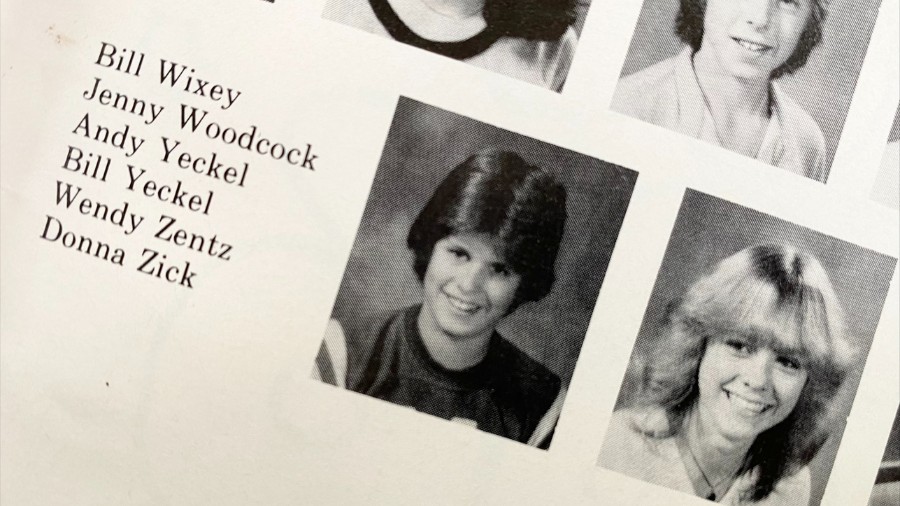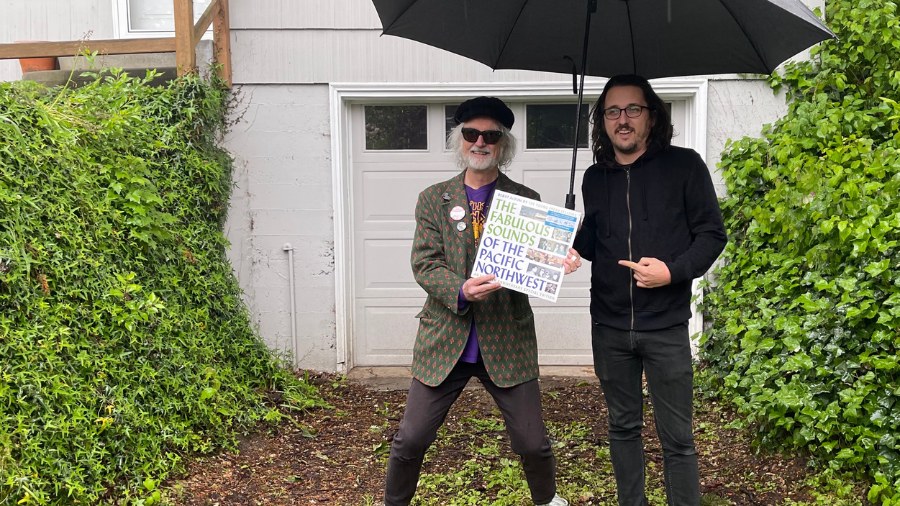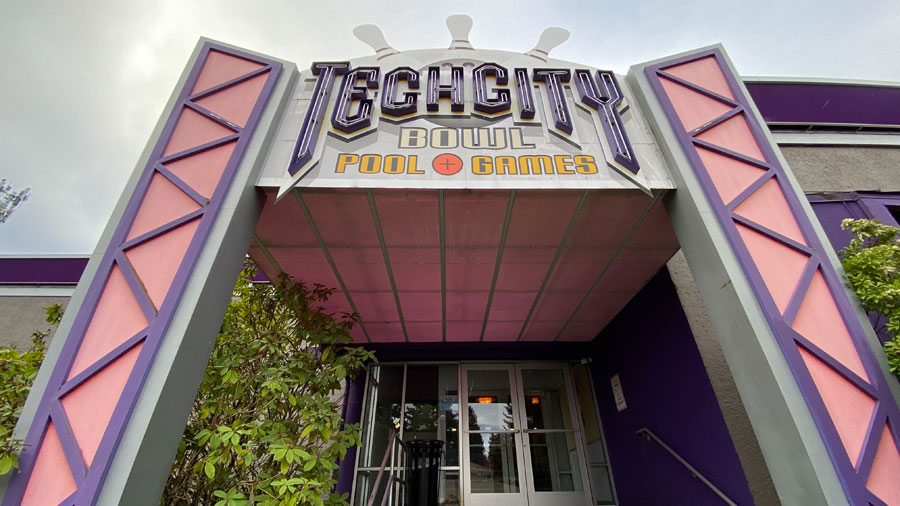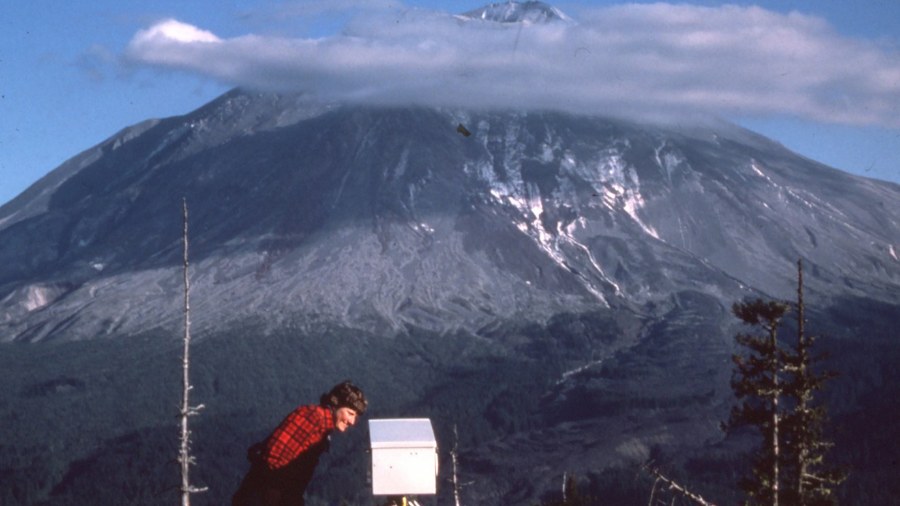All Over The Map: Is ‘box the Space Needle came in’ the oldest local dad-joke?
Dec 31, 2021, 8:18 AM
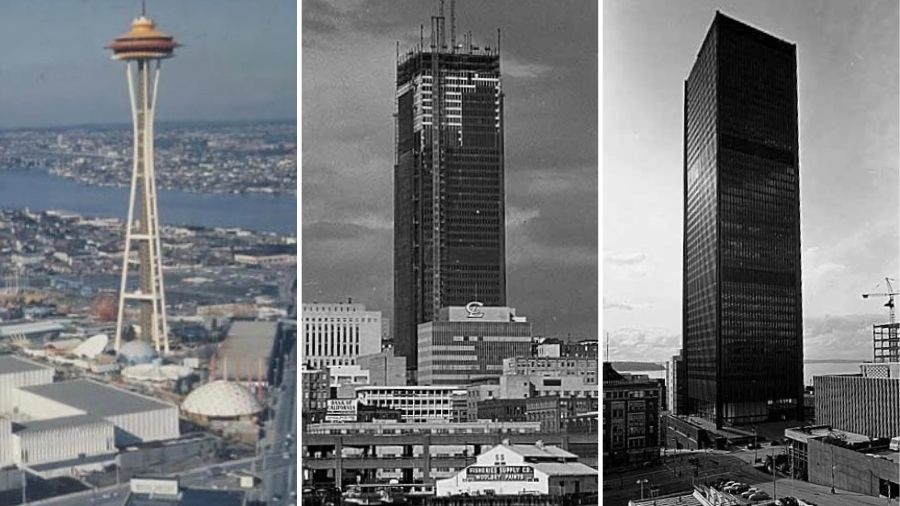
Three images from MOHAI show (L-R) the Space Needle during the 1962 Seattle World's Fair, and the Sea-First Building -- known, though it came several years later, as "the box the Space Needle came in" -- under construction in 1968 (center), and then completed in 1969 (right). (Courtesy MOHAI)
(Courtesy MOHAI)
Despite the snow and cold and all those pesky supply chain issues, the pyrotechnics are back on at the 1962 World’s Fair landmark Space Needle again this year after skipping 2020 because of, say it with me everybody, the COVID-19 pandemic.
The Space Needle has long been a beloved part of the skyline, and the distinctive tower is even responsible for generating an enduring nickname – and perhaps one of the region’s earliest dad jokes – for one of Seattle’s 1960 skyscrapers.
Before we get to that part of the story, the end of one calendar year and the beginning of another has meant fireworks at the stroke of midnight from atop the Space Needle since 1994. With, of course, a few notable exceptions.
It was 22 years ago when the show itself went off without a hitch – but, just like 2021, without any people directly below to watch – when then-Mayor Paul Schell, out of an abundance of caution, banned in-person spectators on New Year’s Eve 1999. Schell’s action, as one of the first mayors in the United States to directly face a credible terrorist threat, came in the wake of the arrest in Port Angeles of Ahmed Ressam. Ressam was apprehended with a car full of explosives as he tried to enter the U.S. from Canada; he was convicted, and remains imprisoned in Colorado.
In 2007, a computer glitch meant the start of the show was delayed by a few minutes. And last year, though there were no actual fireworks, a “virtual” show was visible on digital screens that had some locals shaking their heads. Incidentally, a 1994 Seattle Times correction notes that fireworks were first launched from the Needle in 1972, to mark the 10th anniversary of the World’s Fair.
Sharper-than-average Seattleites will remember that the fireworks were cancelled the year before the pandemic took hold – back in December 2019, when the disease was already spreading in Asia – because of high winds. Thus, on New Year’s Eve 2021, the city’s December 31 fireworks have actually been absent from the Northwest’s most recognizable spire for an astounding 36 months.
Back in the present, whether real, virtual or no fireworks actually happen (and happen on time) on New Year’s Eve 2021, all of this is a good excuse to try and track down the origins of the nickname for a downtown Seattle skyscraper still known by many as “the box the Space Needle came in.”
The giant cardboard container-like structure in question is located downtown between Third Avenue and Fourth Avenue, and between Spring Street and Madison Street. It’s nowadays called Safeco Plaza and was recently sold, but this distinctively non-distinctive tower was originally constructed as the Seattle-First National Bank Building beginning in 1966. This was when good old Sea-First was still headquartered in Seattle, and nearly two decades before Bank of America took over the storied local financial institution in the 1980s.
A listener named Mark Neuman reached out to KIRO Radio to ask about the origins of the nickname, which he remembers from his childhood more than 50 years ago – and which still regularly appears in local media (including when the building sold earlier this year), and which is still remembered by countless local residents.
“It was 1969 and I was 10 years old,” Neuman wrote. “My Dad [the late Glen Neuman, 1920-2000] made the remark as we were turning on to Admiral Way in the family station wagon in West Seattle where we grew up. You couldn’t help but notice the building going up from the viewpoint there.”
“Well, when you are 10 years old you think your Dad is the funniest guy on Earth,” Neuman continued. “But I would hear and read the phrase SO MANY times over the years, that I figure he had read it in Emmett Watson’s column in the Seattle P-I. I never thought to ask him where he heard/read it first.”
The All Over The Map team kicked into gear within moments of receiving Mr. Neuman’s correspondence (we love this kind of thing, as is hopefully obvious by now). We combed through old newspapers and pored over vintage local history books to try to seek out the source of this vintage, hyper-local – and perhaps even protozoic – dad joke.
The earliest reference the team could find in print was in the Seattle Times from December 1, 1968 when the Sea-First Building was still under construction. In writer Alf Collins’ column that day, he wrote, “We are cheered to learn that Herb Schiessl, Jr., a Fentron executive, refers to the Sea-First Building as ‘the box the Space Needle came in.’” While technically not giving Schiessl credit, it’s not a stretch to interpret Collins’ column as lauding Schiessl for coining the phrase.
Fentron was a window manufacturer based in Ballard with offices all over the western United States. The company fabricated aluminum framed windows for all kinds of important Seattle buildings going back to the 1950s – including the city’s first modern tower, the Norton Building and for the Sea-First Building, too. It’s easy to imagine Mr. Schiessl as a man-about-downtown, with his finger on the pulse of big construction projects – where Fentron was in the know about building details long before the general public (or even before Emmett Watson). With this access, the imagined scenario goes, Schiessl is perfectly positioned to come up with the cute nickname, and to spread it around through his downtown friends and colleagues.
Reached by phone at home on Lopez Island earlier this week, 79-year old Herb Schiessl, Jr. says he remembers the Seattle Times column from more than half a century ago. But, Schiessl says, he wasn’t the one who actually came up with the resilient nickname.
“I was at a gymnasium working out,” sometime in November 1968, and not far from the Space Needle, Schiessl told KIRO Radio.
The gym was called Studio Physical Culture, and a discussion was underway amongst the other men there who were also exercising, “and that term came up, because there was quite a discussion that the Space Needle was naturally quite large and [one of the men there said] that the new building was large enough to be the box” for it, Schiessl said.
“I agreed with him, ‘Yes, that’s spectacular. That building is 600 feet tall,’” Schiessl continued.
But who, exactly, was this mysterious and physically-fit wordsmith from the LBJ era?
Unfortunately – and understandably – Schiessl just can’t remember.
“But then that got published,” Schiessl said, referring to the December 1, 1968 newspaper column – though he says he’s not sure how the Times’ Alf Collins heard about it. Regardless, Schiessl got the credit.
As it turns out, Schiessl also got the blame.
“Some of the people involved were not too pleased with that [phrase],” Schiessl said, referring to perhaps NBBJ, the architecture firm who designed the Sea-First Building, or Howard S. Wright Construction, the company that built it. “They thought it was kind of a slam in the face, I think. Here you build a building, and then somebody basically criticizes you for saying, ‘the Space Needle came in that box.’”
But wasn’t the nickname always more of a friendly, non-derogatory term of endearment – that is, it was not anything meant to be critical?
“That’s how I felt,” Schiessl said.
Being associated with the iconic landmark from the 1962 Seattle World’s Fair was “a feather in the cap for the people that designed the Sea-First Building,” he pointed out.
Pressed for more clues as to the possible identity of that long-ago gym patron, all Schiessl can remember is that the other men exercising in the club that day were significantly older than Schiessl, who was 26 at the time.
A check with the company that owns and operates the Space Needle adds one more clue, courtesy of Randy Cote, director of business development.
In an email, Cote writes, “Since the building had the same construction company as the Space Needle — Howard S. Wright Construction – [and] was the next tallest building in Seattle after the Space Needle, and [because] the Needle could effectively ‘fit inside’ the tower, it’s easy to see how it got the nickname!”
For the record, Cote is correct regarding the fit: the Space Needle is listed as 605 feet tall, and the Sea-First Building clocks in at 630 feet.
And as to whether the paternity for this particular dad joke can ever be officially established or not, as KIRO Radio’s Dave Ross points out, the logic of the timing of this treasured local packaging myth doesn’t quite stand up to a Cornell grad’s scrutiny – since the 1966 “box” for the 1962 Space Needle technically arrived many years too late to actually serve as the shipping container for the Needle.
Thanks for that, Dave.
If you know of further details regarding the origin story for “the box the Space Needle came in”—or, if you feel like creating a Wheedle on the Needle-like myth about it, we want to know! Please reach out via the contact information below, and feel free to get in touch if there are other local buildings, local places, local stories – or even local dad jokes – that you wonder about.
You can hear Feliks every Wednesday and Friday morning on Seattle’s Morning News, read more from him here, and subscribe to The Resident Historian Podcast here. If you have a story idea, please email Feliks here.


